Support strong Canadian climate journalism for 2025
If we’re going to have economic stimulus, it ought to be green. That sentiment has achieved surprising levels of agreement around the world, and not just from the usual suspects.
Nobel-winning economists, financial experts and even the highly conservative International Energy Agency (IEA) are all pushing governments to use stimulus to decarbonize the economy.
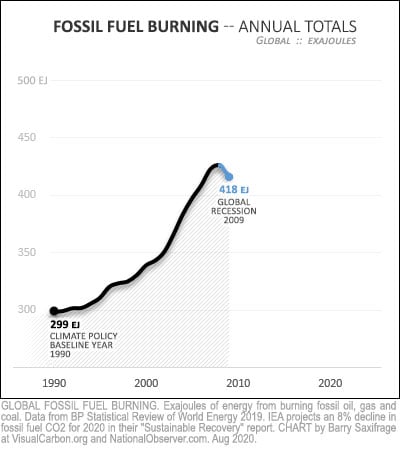
And for good reason: the last time we had a financial meltdown it was followed by a record surge in fossil fuel burning.
Have a look at this first chart.
Despite decades of promises to prevent a full-blown climate crisis, its primary cause — fossil fuel burning — was rising relentlessly.
Then the Great Recession hit in 2008-9 and caused the only drop in global fossil fuel burning in the last 30 years.
At the time there was hope that governments would use their huge, future-shaping stimulus to transition to a climate-safe economy.
To see what actually happened, look at the next chart.
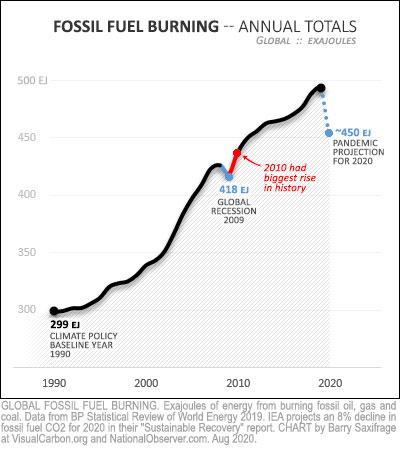
Instead of a climate-safe recovery, fossil fuel burning surged upwards in 2010 by the greatest amount in history.
And every year since then, despite all the global protests, the gatherings of the United Nations, the boom in renewable energy — despite everything — humanity has continued to burn even more fossil fuels with each passing year than in the year before.
Now, in 2020, the coronavirus pandemic is raging across the globe.
A report from the IEA projects the resulting global economic contraction will push fossil fuel burning down about eight per cent this year. That's the dotted blue line on the chart.
And then what? According to the IEA, “a similar rebound in emissions can be expected after this crisis unless there is effort by governments to place clean energy transitions at the heart of the economic recovery.”
It’s not just that economic stimulus is an opportunity to accelerate the transition to a net-zero economy. It’s crucial that we don’t accelerate deeper into danger, like we did after the last recession. After all, the climate doesn’t care how much clean technology we deploy, it only cares how much carbon builds up in the atmosphere from the fossil fuels we burn.
So, the question for every government becomes: how much money are you spending on fossil fuels during the pandemic recovery?
Fortunately, a new coalition has come together to track the answers from each of the world’s largest economies. We’ve taken this data compiled by Energy Policy Tracker and charted new government support for fossil fuels by each of the G20 countries since the beginning of the COVID-19 crisis. (Note that to allow fair comparisons across countries, the charts list all values in USD per capita.)
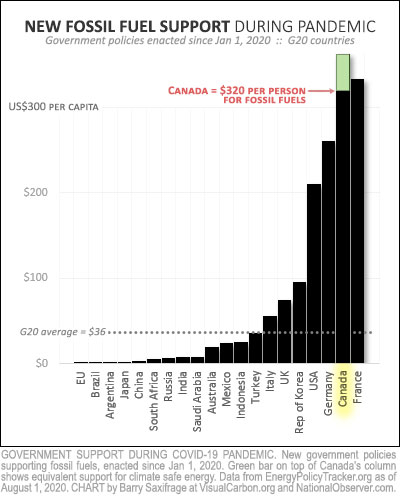
As you can see in this first G20 chart, Canadians are at the top of the fossil support charts. Canada has committed nearly ten times the G20 average per capita — for a total of $12 billion so far this year in new fossil fuel support. Only France, with its massive bailout of Air France, has managed to spend more per person, at this point.
You can also see that we’ve added a little green cap onto the top of the bar representing Canada. That’s the amount of money Canadian governments have committed to clean energy (again, per capita). We could belabour this point but, really, the prioritization speaks for itself.
Now, it’s worth pausing to make a few points here.
First is that this is a running tally of money committed since the pandemic began. So, the numbers for clean and fossil energy will keep rising as new policies are announced. The coalition updates the tracker every Wednesday.
Second, Energy Policy Tracker is only tracking money explicitly committed to energy. More general spending that benefits the energy sector along with others isn’t represented here, so the actual support to the energy sector is significantly higher.
And finally, as the coalition points out, “these public money commitments are additional to many other government policies that had existed to support different energy types before the COVID19 pandemic” (emphasis added).
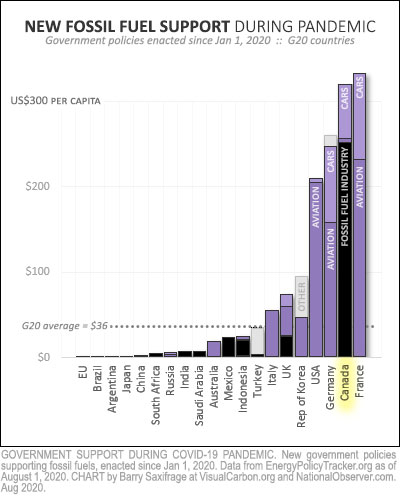
Now, let’s get back to the charts.
You may be wondering about the specifics. The next chart shows the top 3 categories where countries have been directing fossil energy support: aviation, ground transportation (which includes support to gasoline and diesel vehicles as well as expanding highways and bridges) and the fossil fuel industry itself.
The aviation industry is the biggest overall recipient of new public funds being pumped into fossil fuel burning.
But at this point, Canadian governments have focused most of their public funds on the fossil fuel industry itself.
One thing you may notice is that despite all the news about U.S. President Donald Trump bailing out U.S. coal and the American oil and gas industry, not much money has actually been committed.
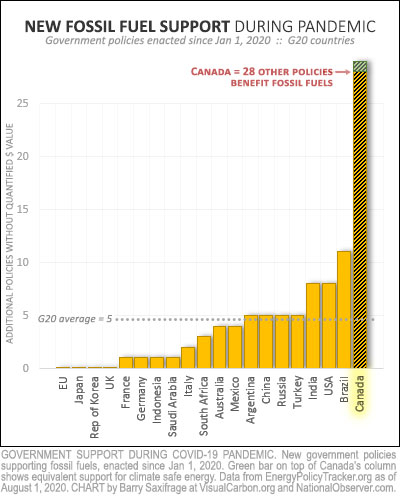
Instead, most of Trump’s support for fossil industries has come in the form of rollbacks to regulations and environmental safeguards.
There has been a lot of handwringing about this issue in the U.S., so the next chart shows the number of additional policies that benefit fossil fuels but where the “value of public money is unquantified.”
And for Canada, we have included the number for clean energy — just one so far — as a green bar on top.
Clearly much more media scrutiny should be directed to this topic in Canada, especially considering the latest news of major cuts to environmental monitoring of the oilsands.
The Energy Policy Tracker includes policies from both national and subnational governments. In Canada, the provinces are playing an oversized role, as the next chart shows.
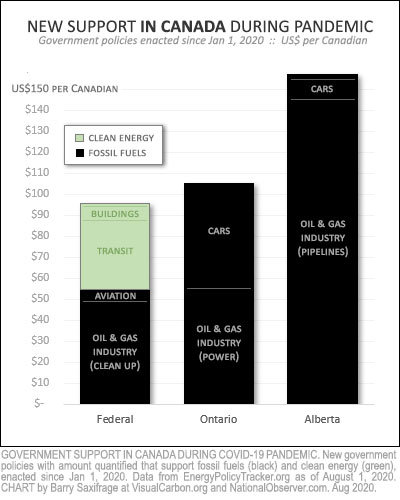
Here we finally find some positive news. The federal government has put a much higher priority on supporting clean energy than the overall Canadian numbers suggest.
And the overwhelming chunk of its support for fossil energy is directed at cleaning up abandoned oil wells — a subsidy for the oil and gas industry, to be sure, but one where there’s at least a public interest argument.
Ontario is pumping double the feds’ numbers into support for fossil fuel burning — by purchasing power plants running on fossil gas as well as almost two billion for highways and bridges.
Alberta has committed more than three times the federal numbers with the province’s commitments to invest directly in the Keystone XL pipeline and guarantee its loans next year.
What’s even more striking is that, to keep things consistent, we’ve kept using per capita numbers, per Canadian. So, the provincial commitments to fossil fuel burning per provincial resident would be much higher. For example, Alberta's fossil support works out to $1,370 per Albertan. Way off the charts.
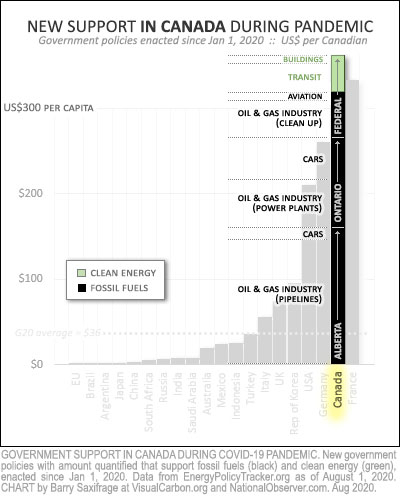
If you’d like to see how those two provinces stack up against entire G20 countries (even using those conservative per Canadian numbers), take a look at this chart.
We've broken down the Canadian bar to show the public money committed to energy by Alberta, Ontario and the feds, as well as where that money is going. And you can see how it all compares to the world's other major economies.
Alberta and Ontario are burning their way almost to the top of the G20 fossil charts by themselves.
To close out this sobering look at Canadian governments’ support for fossil energy in a time of pandemic, let’s remember that the situation isn’t a COVID-19 anomaly.
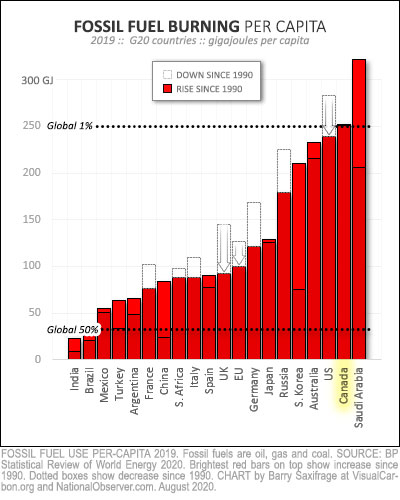
As the final chart shows, when it comes to the amount of fossil fuels burned every year, Canada is second only to Saudi Arabia in the G20 — in terms of total fossil burn per capita.
Both countries are in the global top one per cent, burning more fossil fuels per person than 99 per cent of humanity.
And unlike our peers in the United States, the European Union and the United Kingdom, we haven’t yet begun to reduce our burn rate at all.
Canadian governments will be rolling out more pandemic recovery spending in the months to come. We will see how much of a priority they place on the clean energy transition.
Green stimulus would certainly be better than more support for fossil fuels. But it’s even more important that we start dousing the fire. Canada does not yet have a plan to meet its commitments under the Paris agreement. Let alone a plan to achieve the federal government’s promise of net-zero carbon emissions by 2050.
So, yes, if we’re going to have economic stimulus, it ought to be green. But let’s put out the fire that’s already blazing.





Comments
Exemplary work, Barry and Chris! But egregious policy failure, Canada.
There's nothing funny about this, but "Canada" will still talk about how it is/can become/should be a "leader" in the fight against climate change. That cracks me up every time I hear it or read it. For some crazy reason, It's still impossible to get from Toronto to Vancouver when you're heading full-speed (in reverse, no less!) toward Halifax.
Fossil fuel burning is currently a necessary evil, but the case against it is not strengthened by sloppy and alarmist interpretations of the data. This example is from the first graph:
"Instead of a climate-safe recovery, fossil fuel burning surged upwards in 2010 by the greatest amount in history." Looking at the first and second graphs, the so-called record surge is not a record increase, it is just a resumption of the general trend. There is nothing surprising about this. This is distortion of the facts to gain shocking headlines - click bait!
Why, in any case, would one expect a financial crisis to cause a reset in the energy economy? Fossil fuel burning is built into our long-life infrastructure: millions of home heated by natural gas; millions of suburbanites committed to fossil fuel transportation to get to work; millions of people lighting there homes with coal-powered and natural gas powered electricity. Other than suddenly reducing our standard of living by shutting down the economy, there is no way we can swiftly reverse this trend. An analysis of the problem at this level would be most welcome; proposed solutions, with implementation timelines, rather than pretty graphs with questionable interpretations and exhortations, would be even more welcome
Oh please!! So just because burning carbon is what we have always done, that makes it a must to continue? Nitpicking through the data presented here does not substantiate this egregious contention! Climate deniers simply need to find themselves an island and stay put on it!
Thanks for digging in. The first link will take you to a comprehensive overview of decarbonizing economic stimulus options recommended by int’l financial experts.
There’s no reason Canada has to keep increasing carbon emissions and fossil fuel burning. The UK has reduced over 40% in the past 30 years while we’ve been increasing. See for example this article outlining the solutions policy architecture: https://www.nationalobserver.com/2020/05/29/opinion/canadas-emissions-r…
As far as the 2010 numbers - you’re right that it’s a return to the prior trend of annual increases. But the data are clear that it’s the single largest year-to-year increase on record
A few points, Mr. Ball, in re a couple of the incorrect statements you've made.
WRT 2010: by now, it's the rare Canadian who cannot interpret a rising slope in a linear graph to equate to faster growth, and therefore a larger number over a given timeframe. I'd invite you to place a straight edge against the 2010 bit of the graph, and, maintaining that slope, slide the edge left-ward, back toward the origin of the graph. It will be immediately clear that in no other graphed year is the slope of the line (=greatest rate over a one year period) equal to or less than the 2010 the slope (steepness of the line, for anyone who doesn't remember -- or never passed -- Grade 10 math).
The nonsense about the necessity of growing the tarsands because we use natural gas in the meantime ... has got to be the biggest crock ever for storing BS.
Before commenting about everything that's wrong with facts, one might, in the position of contradicting fact, at least educate oneself about the basics. Hint: that doesn't mean swallowing the whole bolus of CAPP propaganda. They are the chief-meisters of bullshit in Canada.
Why bother "getting through" COVID alive, only to die of heatstroke, flooding, or starvation.
No, sir, taxpayers have fed the petro industry and its foreign feasters way too long already. Time to get with a survival program!!!
And if some people need to give up their airplane rides, skidoos, RVs, motorboats ... well so be it. Who the hell do they think they are, anyway, to have evolved over the space of 3 short generations, that their lives depend on them? Who the hell does the petroleum industry think it is, that they have an inherent right to kill the entire planet?
An excellent article showcasing the art of Media manipulation of information to promote the environmental propaganda agenda. The use of "per capita" data is so misleading when you are referring to Countries with dramatically different populations.
When you use real numbers such as Total emissions it is a completely different picture but not nearly the dramatic effect the journalist is looking for. Gotta go for the hype to make a name for yourself in the public eye.
Last I seen we were 1.6% of the Total emissions in the world. Not quite as dramatic I know.
Can we do better? Absolutely. Will it happen quickly? Nope. To convert utility infrastructure takes years even with focused determination.
Meanwhile Canada will keep working and the innovation will continue to improve and it will happen without the media bs. There is lots of opportunities here and in the World for Canadian technology.
Science is not fiction. The petro industry's propaganda is.
1.6% of total emissions, in a country with something like .4% of the world's population. We are punching way about our weight, in terms of production and consumption of the portion of our GWGs that are even being admitted to.
Last I heard, most countries were populated by humans. Last I heard, one small part of Canada has wiped out all the progress all the other provinces made over the past 15 years.
Will it happen quickly? Not as long as CAPP rules ... not as long as Alberta (and a small bit of Saskatchewan) insist on yelling their uneducated, anti-science and fictional opinions at the top of their entitled lungs. Have you any idea, at all, how disgusted the far majority of people in virtually every other province are, with such shenanigans? How reviled "Alberta" has become, because of it?
You know, I have many relatives in Alberta. Some of them might well be as uneducated and rednecked as the proponents of the above point of view tend to be ... but the truth of the matter is, if they are, they are just wrong. Not morally, or ideologically, or in any other theoretical way wrong: *factually* wrong.
There already exists the technology and the financial capacity to attain net zero emissions considerably before 2050. Those numbers have been run.
The rest of the world awaits Alberta getting with the program.
Already, banks and insurance companies are refusing to underwrite new projects. It's a scant matter of time before they refuse to renew loans and policies. The writing is on the wall, and those who refuse to see it will be left ... I was going to say dust, but perhaps ashes and slag would be more apt.
Pension funds in most countries are divesting themselves of fossil fuel investments, and of interests in financial sector bodies that don't do likewise.
You've got to wonder why companies would walk away from the Great Deal for All that Mr. Kenny & Co would have you believe the tarsands are. Tarsands are where old elephants go to die. Right now, the petro corp elephants are wearing albatrosses around their necks.
So enough of the uncritical acceptance of the fantasy fiction of the oil producers. It's over, boys: the party's over.
Ray Weleschuk wrote: "The use of 'per capita' data is so misleading when you are referring to Countries with dramatically different populations."
To compare behavior of populations of disparate size, per capita is PRECISELY the measurement to use.
Per capita statistics measure people's emissions profile without regard to their nations' population size. To avoid absurd comparisons like China and Belgium.
It is not valid to compare large groups of people with small groups (except by using per capita stats). You cannot compare China's emissions with Belgium's. Or Cardston's, Calgary's, and Canada's.
Per capita helps us tell the high emitters from the low, no matter the size of their nation. Per capita tells us, for example, that Canadians and Americans are similar in their extravagant energy habits and emissions.
With just 4% of the world's population, the U.S. accounts for more than one fifth of global oil consumption. Gross inequity. Canadians live much like Americans.
The average Canadian's carbon footprint is more than twice that of the average Chinese and 8x that of the average person in India.
How can we ask them to tighten their belts when our emissions are far higher?
The fact that large groups of low emitters have greater total emissions than small groups of high emitters does not give high emitters a free pass — or excuse them from their greater responsibility for the problem.
Canadians' emissions are 3x the global average. Albertans' emissions are more than 10x the global average. If people around the world copy us, global emissions would skyrocket. Canada ranks 10th in total emissions overall. Nowhere near tenth in population.
If Canada exempts itself from meeting climate targets, why wouldn't other countries do the same?
The "Little Canada" argument is fallacious. The climate problem cannot be solved if only the most populous nations or top emitters reduce emissions.
China, India, and the U.S. cannot solve the problem alone. Even if the top three emitters reduced emissions to zero, that would still leave about half of global emissions on the table. Unless smaller national emitters do their part as well, global targets remain out of reach.
"All nations contributing less than 2% of emissions are, cumulatively, more important than India or China. It absolutely does matter that these nations reduce their emissions." (Willem Huiskamp, Potsdam Institute for Climate Impact Research)
Using Canada's nominal (under-) estimates, 147 countries emit less climate pollution than AB's oilsands industry. 169 countries emit less climate pollution than AB. 187 countries emit less climate pollution than Canada.
If Canada is "too small to matter," what message does that send to the 187 nations with smaller carbon footprints than ours?"
Yes, we are at 1.6% of world total emissions (knowing, however, that this excludes the embedded emissions in our exports and consumer imports). That is one of the most important misleading bits of propaganda put out by fossil fuel industry apologists and paid climate deniers / delayers / doubters. But we are also at 0.5% of world population. Do the math already. We are the pigs of the planet, and no, living in a cold country doesn't explain that.
WAKE UP CANADA !
"Canada defends role for oilsands projects in 'messy' energy transition"
Canada defends the indefensible.
https://edmontonjournal.com/financial-times/canada-defends-role-for-oil…
Canada has no intention of meeting its 2050 targets and no roadmap to get even close.
Canada grossly under-reports its oil & gas emissions to begin with.
*
Canada hasn't reduced emissions at all. According to the latest National Inventory Report, Canada's GHG emissions in 2018 under climate leader Trudeau hit levels not seen in a decade. Despite closure of Ontario's coal plants.
Oil & gas industry emissions climb year after year. Alberta's emissions show no sign of falling.
*
The UN, the OECD, and the federal Environment Commissioner all issued warnings in 2017 that Canada is NOT on track to meet its targets. The main obstacle? Rising oilsands emissions.
OECD: "Without a drastic decrease in the emissions intensity of the oilsands industry, the projected increase in oil production may seriously risk the achievement of Canada's climate mitigation targets."
*
The IPCC warns that we must nearly halve GHG emissions by 2030 and eliminate them by 2050 to keep warming below the danger limit of 1.5 C.
According to the new climate deniers (Trudeau, Notley, and Horgan head the list), the path to renewable energy and a sustainable future runs through a massive spike in fossil-fuel combustion and emissions. Complete disconnect from the science.
"The New Climate Denialism: Time for an Intervention" (The Narwhal, Sep 26, 2016)
• https://thenarwhal.ca/new-climate-denialism-time-intervention
*
The Liberals have proved far more effective than the Conservatives in delivering on Big Oil's and Corporate Canada's agenda.
Predatory delay and climate disaster. That was always the plan.
Sad to say, but the only thing that can stop the oilsands juggernaut is a series of massive lethal heatwaves and wildfires in Europe and the U.S., claiming hundreds of thousands of victims.
Only then will sufficient political pressure be brought to bear upon governments and the big banks/insurance companies that finance oilsands extraction.
Electrification of transportation will help, but with their huge footprint electric cars are a detour from sustainability. The real solution? Public transit, intelligently designed cities built for people (not cars), and an end to urban sprawl.
While it's never too late to cut emissions, by the time we come to our senses, massive damage will have been done.
With 30 years in urban design, I'm with you on transit-oriented, walkable urbanism. But even that requires a Transition Plan given the challenge presented by the huge "success" of car / oil-dependent suburbs. The Plan must address urbanizing the suburbs, starting with converting auto-oriented malls ringed by thousands of square metres of asphalt parking lots into genuine towns and villages using Smart Growth planning and humanist urban design principles, assisted by high-capacity commuter or rapid rail networked with neighbourhood trams, poly-zoned commercial high streets with pedestrian priority, and extensive bicycle road systems.
Meanwhile, liquid petroleum fuels are about to face a tapering in demand, mainly by EVs, given the published intentions of all the big car makers. That is a third party economic scenario that could be catalyzed further with better grants for EVs along with a more extensive array of public grants for electric heat pumps, solar PV panels, Passive House and other super-efficient models in architecture and engineering, and so on. The whole package. Yes, EVs are still cars, but that is where creating time to build transit and human-scaled communities come to the fore, mainly by making car ownership redundant with the convenience and pleasantness of walking no more than 10-minutes to a wide assortment of neighbourhood shops, and by building a frequent transit network linking everything together.
Trudeau must be challenged to consult on, develop and publish a comprehensive Climate Transition Plan after five years of rhetoric. Anything less -- such as meaningless statements like 'carbon neutrality by 2050' yada yada -- is a cop out by a weak leader with poor science advisers.
Geoffry Pounder -- good points.
My mom never allowed me to justify anything I did that wasn't smart because (a) others were doing it, (b) I did it to a lesser extent, (c) I was only small and peripheral, etc. Knowingly being bad or a jerk or wilfully stupid compounded the error of my ways.
The same applies to Canada. Others being dirty and dirtier doesn't mean we shouldn't do the right things, in the right ways, for the right reasons -- as best we can manage and extrapolate from. These are the only workable and moral guidelines we all have, from the personal to the global level, for operating a decent world and sustainable planet.